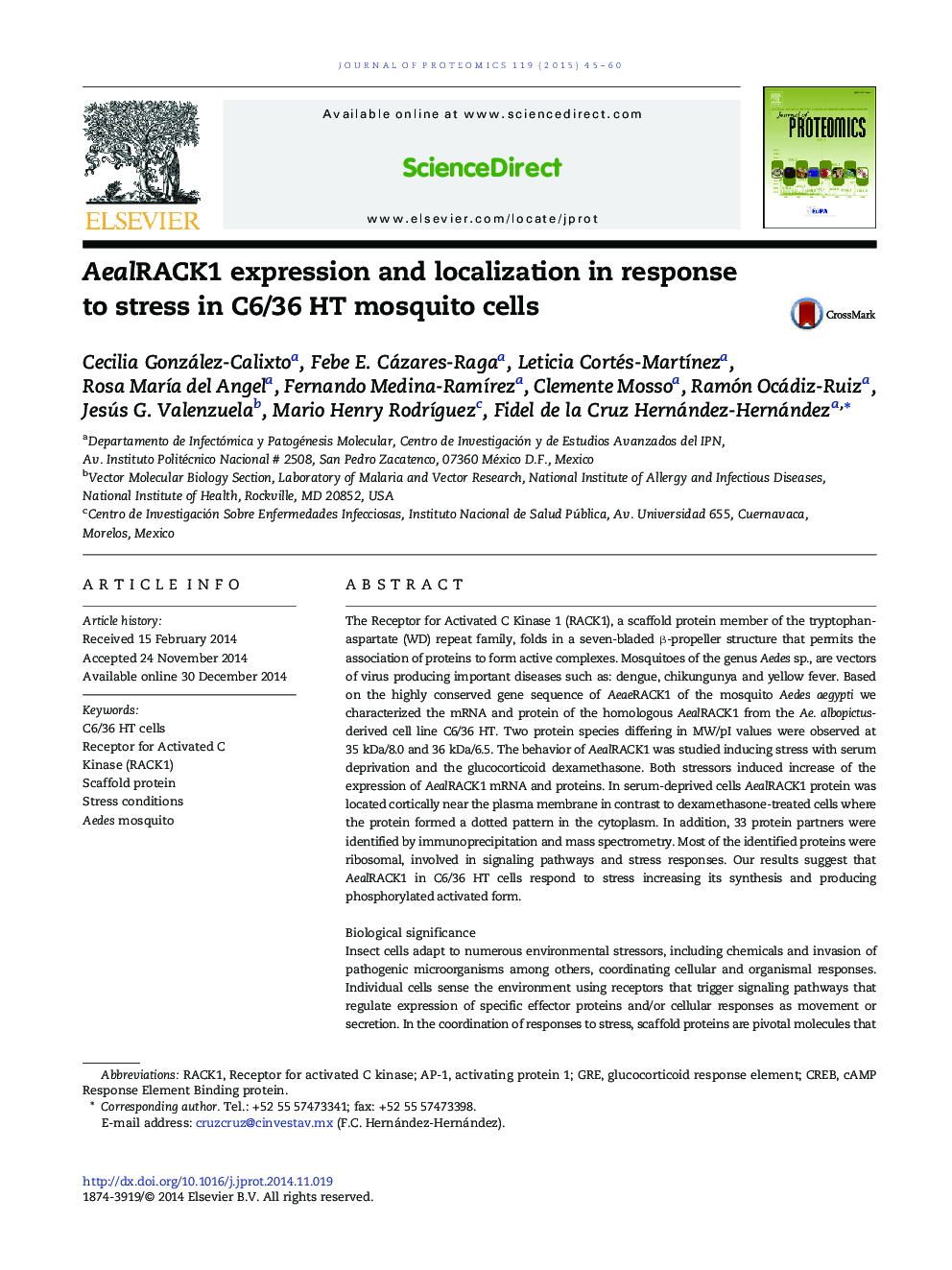| کد مقاله | کد نشریه | سال انتشار | مقاله انگلیسی | نسخه تمام متن |
|---|---|---|---|---|
| 1225366 | 1494761 | 2015 | 16 صفحه PDF | دانلود رایگان |

• We identified and characterized RACK1 sequence from Aedes aegypti (AeaeRACK1) databases.
• Protein and mRNA of RACK1 were demonstrated in C6/36 HT cells from Aedes albopictus (AealRACK1).
• AealRACK1 expression was increased in stress conditions: serum starvation and treatment with dexamethasone.
• There are two AealRACK1 species differing in PTMs that are produced differentially under stress.
• AealRACK1 have different subcellular localization in stress conditions.
• AealRACK1 associate with proteins involved in ribosomal function, signaling and stress response.
The Receptor for Activated C Kinase 1 (RACK1), a scaffold protein member of the tryptophan-aspartate (WD) repeat family, folds in a seven-bladed β-propeller structure that permits the association of proteins to form active complexes. Mosquitoes of the genus Aedes sp., are vectors of virus producing important diseases such as: dengue, chikungunya and yellow fever. Based on the highly conserved gene sequence of AeaeRACK1 of the mosquito Aedes aegypti we characterized the mRNA and protein of the homologous AealRACK1 from the Ae. albopictus-derived cell line C6/36 HT. Two protein species differing in MW/pI values were observed at 35 kDa/8.0 and 36 kDa/6.5. The behavior of AealRACK1 was studied inducing stress with serum deprivation and the glucocorticoid dexamethasone. Both stressors induced increase of the expression of AealRACK1 mRNA and proteins. In serum-deprived cells AealRACK1 protein was located cortically near the plasma membrane in contrast to dexamethasone-treated cells where the protein formed a dotted pattern in the cytoplasm. In addition, 33 protein partners were identified by immunoprecipitation and mass spectrometry. Most of the identified proteins were ribosomal, involved in signaling pathways and stress responses. Our results suggest that AealRACK1 in C6/36 HT cells respond to stress increasing its synthesis and producing phosphorylated activated form.Biological significanceInsect cells adapt to numerous environmental stressors, including chemicals and invasion of pathogenic microorganisms among others, coordinating cellular and organismal responses. Individual cells sense the environment using receptors that trigger signaling pathways that regulate expression of specific effector proteins and/or cellular responses as movement or secretion. In the coordination of responses to stress, scaffold proteins are pivotal molecules that recruit other proteins forming active complexes. The Receptor for Activated C Kinase 1 (RACK1) is the best studied member of the conserved tryptophan-aspartate (WD) repeat family. RACK1 folds in a seven-bladed β-propeller structure and it could be activated during stress, participating in different signaling pathways. The presence and activities of RACK1 in mosquitoes had not been documented before, in this work the molecule is demonstrated in an Aedes albopictus-derived cell line and its reaction to stress is observed under the effect of serum deprivation and the presence of glucocorticoid analog dexamethasone, a chemical used to cause stress in vitro.
Figure optionsDownload high-quality image (182 K)Download as PowerPoint slide
Journal: Journal of Proteomics - Volume 119, 24 April 2015, Pages 45–60